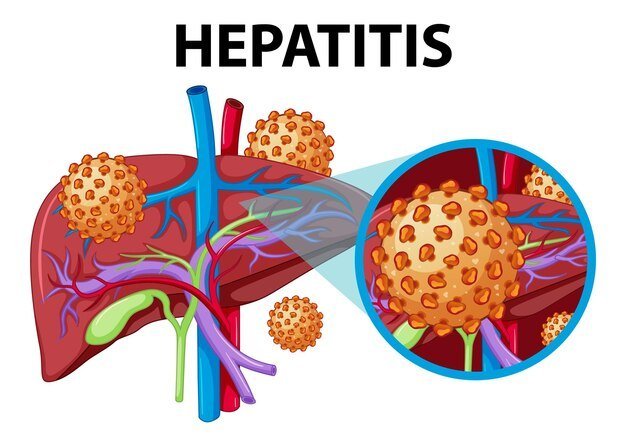The word “hepatitis” refers to an inflammation of the liver. It can be caused by viruses, alcohol misuse, autoimmune diseases, or certain medications. That viral disease is the most common type, with five main types: Hepatitis A, B, C, D, and E. Each type differs in its hepatitis vaccine, transmission, symptoms, and treatment.
II. Types
- Hepatitis A
- Hepatitis B
- Hepatitis C
- Hepatitis D
- Hepatitis E
III. Hepatitis A
Hepatitis A is a highly contagious liver infection caused by the Hepatitis A virus (HAV). It is typically spread through contaminated food or water or close contact with an infected person. These infection is preventable through vaccination.
IV. Hepatitis B
The Hepatitis B virus (HBV) is the main cause of the dangerous liver infection. It can be acute or chronic and is transmitted through contact with infected blood or bodily fluids. Hepatitis B can lead to chronic liver disease and liver cancer.
V. Hepatitis C
It is a liver disease caused by the Hepatitis C virus (HCV). It is usually spread through blood-to-blood contact with an infected person. These type can lead to chronic liver disease, liver cirrhosis, and liver cancer.
VI. Hepatitis D
It also known as delta hepatitis, is a liver disease caused by the Hepatitis D virus (HDV). It occurs only in people who are infected with the Hepatitis B virus. These virus is uncommon but can lead to severe liver damage.
VII. Hepatitis E
The Hepatitis E virus (HEV) is the cause of the liver illness known as hepatitis E. It is usually spread through contaminated water. That is common in developing countries and can cause severe illness, especially in pregnant women.
VIII. Hepatitis A Symptoms
- Fever
- Fatigue
- Loss of appetite
- Nausea
- Abdominal discomfort
- Dark urine
- Jaundice (yellowing of the skin and eyes)
IX. Hepatitis B Symptoms
- Fatigue
- Jaundice
- Abdominal pain
- Loss of appetite
- Nausea
- Joint pain
- Dark urine
X. Hepatitis C Symptoms
- Fever
- Fatigue
- Loss of appetite
- Nausea
- Abdominal pain
- Jaundice
- Dark urine
XI. Hepatitis E Symptoms
- Fatigue
- Jaundice
- Nausea
- Abdominal pain
- Dark urine
- Clay-colored stool
XII. Hepatitis D Symptoms
Symptoms of Hepatitis D are similar to those of Hepatitis B but can be more severe and lead to rapid liver failure.
XIII. Hepatitis A Vaccine
The A hepatitis vaccine is highly effective in preventing Hepatitis A infection. It is recommended for all children at age 1 and for adults who are at risk of infection or traveling to areas with high rates of it.

XIV. B Type Hepatitis Vaccine
This hepatitis vaccine is safe and effective in preventing liver infection. It is usually given as a series of three or four shots and is recommended for all infants, as well as adults who are at risk of infection.
XV. Hepatitis B Treatment
Treatment for HBV aims to reduce the risk of liver damage and complications. It may include antiviral medications, liver transplant (in severe cases), and lifestyle changes to support liver health.
XVI. Hepatitis B Surface Antibody
The Hepatitis B surface antibody (HBsAb) is produced in response to HBV vaccination or infection. It indicates immunity to B type virus and protection against future infection.
XVII. B Hepatitis Vaccine Schedule
This hepatitis vaccine is typically given as a series of three or four shots over a period of six months. The schedule may vary depending on the age and health status of the individual.
XVIII. Hepatitis B Transmission
These type of virus is transmitted through contact with infected blood or bodily fluids, such as during unprotected sex, sharing needles or syringes, or from mother to baby during childbirth.
XIX. Hepatitis C Transmission
It is primarily spread through blood-to-blood contact with an infected person. This can occur through sharing needles or syringes, receiving contaminated blood transfusions or organ transplants, or from mother to baby during childbirth.
Summary
In conclusion, understanding the different types of hepatitis vaccine, their symptoms, and preventive measures such as vaccination are important in combating this potentially serious liver disease. Early detection, proper treatment, and lifestyle changes can significantly improve outcomes for individuals living with infection.
Table:
Sure, here’s a table summarizing information about hepatitis types, vaccines, precautions, and diets:
| Type | Hepatitis Vaccine Available | Precautions | Recommended Diet |
|---|---|---|---|
| HAV | Yes | – Wash hands thoroughly | – Avoid raw or undercooked shellfish |
| – Practice good hygiene in food preparation | – Consume cooked foods | ||
| – Avoid contaminated water sources | – Stay hydrated | ||
| HBV | Yes | – Practice safe sex | – Limit alcohol consumption |
| – Avoid sharing needles or personal items | – Maintain a balanced diet | ||
| – Get vaccinated | – Avoid excessive fatty foods | ||
| HCV | No | – Practice safe sex | – Limit processed foods |
| – Avoid sharing needles or personal items | – Include fruits and vegetables in diet | ||
| – Get tested regularly for early detection | – Stay hydrated | ||
| HDV | No specific | – Avoid sharing needles or personal items | – Focus on a liver-friendly diet |
| vaccine, but | – Practice safe sex | – Limit sodium intake | |
| Hepatitis B | – Get tested regularly for early detection | – Include lean proteins like fish and tofu | |
| vaccine can | – Avoid alcohol | ||
| prevent | – Consume whole grains and fiber-rich foods | ||
| Hepatitis D | |||
| HEV | No | – Practice good hygiene in food preparation | – Avoid raw or undercooked meat and seafood |
| – Avoid contaminated water sources | – Consume well-cooked foods | ||
| – Get tested if experiencing symptoms | – Stay hydrated |
Please note that this table provides general guidelines about Hepatitis vaccine and types, and it’s important to consult healthcare professionals for personalized advice and recommendations.




1 thought on “Hepatitis vaccine, Types, Symptoms and Treatment”